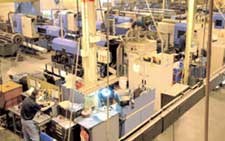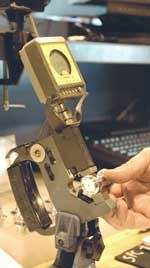Changing Shop Management Software Takes Teamwork
Manufacturer’s hardware platform and shop software upgrades bring added flexibility, simplicity and speed to the network and its processes.
Many small manufacturers either don’t yet have shop management software or are remaining with their first package to avoid the issues of having to change the way they do business. Others who consider upgrading shop software feel they want more from their software vendors, especially in the area of customization. Still others are choosing to migrate from more traditional small business software and hardware systems to the PC platform.
Metal and Seal Products, Inc. (Willoughby, Ohio) is familiar with issues relating to upgrading and customizing software and switching hardware platforms, having faced them several times during the past 15 years. It has recently changed hardware systems again, this time to Dell servers and desktop computers using the Windows operating system. Customization has frequently been necessary at the company, such as when its ISO procedures were implemented.
Featured Content
A Comprehensive Business
This screw machine shop is a tier 2 supplier of auto parts to the Big Three auto makers. It also manufactures plumbing components and assemblies and various precision machined components for other industries.
It employs between 180 to 200 people and ships millions of parts every year. In its plant are more than 100 screw machines of various makes, traditional value-added secondary operation equipment (centerless grinders, drilling, milling, broaching, honing, tapping, thread rolling and assembly), in-house tool fabrication featuring two wire EDM machines and three-axis CNC tool cutter grinds, plus quality assurance and laboratory equipment. The company also has in-house capabilities for anodizing and zinc plating with a certified wet lab for all titrations and performance testing.
Moving To PCs
Michael Bobbitt, the company’s IT administrator, has supported and customized its systems on the previous IBM S/36 and AS/400 hardware platforms. Until recently, the AS/400 handled all manufacturing and accounting activities, along with the customized software systems created by Mr. Bobbitt for tooling, gaging, machine preventive maintenance and QS-9000 activities. When the company decided to change its shop and accounting systems to a Windows 2000 network in 2001, Mr. Bobbitt began evaluating the shop management software available on the PC platform. The company reasoned that switching to the Windows operating system would enable it to take advantage of its user friendliness, as well as its increased flexibility, improved e-mail capabilities and other benefits of increased networking capabilities and speeds.
Mr. Bobbitt explains, “We felt the visual aspects of Windows would give people in management and on the shop floor more flexibility.” Both machine operators and administrators interact with various computer software throughout the office and the plant.
While evaluating the shop management packages available, Mr. Bobbitt observed that most were similar. “Accounting and manufacturing are straightforward, so you would expect that similarity. But on a closer inspection, you find that one vendor may do some things that others may not.”
Customer-Driven Enhancements
To further help the company service its customers, Russell Diemer, Metal and Seal’s general manager, and Henning Software developed a new customer-demand-driven work flow analysis capability program. Called the Production Adjustment Worksheet, it displays color-coded indicators of current demand for a finished product, based on open sales orders across the entire customer base.
The program is a tool supporting intelligent decisions based on the number of releases and number of weeks the plant manager wishes to review it. It aids in decisions to increase or decrease orders to the shop floor to meet demands.
“We constantly get change orders via fax, mail, Internet or EDI,” Mr. Bobbitt says. “None of the software we saw offered a solution for the constant change order, something we had programmed ourselves for the AS/400. While other shops may have the same volume, we handle it differently than others. Henning modified its software to meet that need.
“When we get a change order, we look at the customer’s original request. Updating the dates and quantity adjusts our current production schedule. As that trickles through the system, it adjusts everything else. Our employees can adapt their schedules for other customers, too. Production schedule changes ripple through and automatically adjust everything,” Mr. Bobbitt continues.
Many manufacturers interactively generate invoices and adjust the computer inventory as each job ships. This typically involves only a few invoices. For companies like Metal and Seal, however, which might invoice dozens of shipments daily, its new software activated a batch process for automatically creating the invoices and adjusting inventory from the shipments. Similarly, a new inventory adjustment generator in the software can be used for mass adjustments. Users can update inventory either in a batch mode or individually.
The Conversion Process
Converting from an AS/400-based system to a system operating under Windows on the PC platform can be challenging. But Mr. Bobbitt knew that switching hardware platforms would be a greater effort. He and Rich Henning of Henning Software carefully planned the conversion of files to ensure that the switchover went as smoothly as possible.
“Rich described how his company’s software handled data. I showed how the AS/400 system worked and explained how we expected the data to be handled in his system. Where necessary, he made the software modifications,” Mr. Bobbitt says. “We had to make sure we had the right information properly formatted and in the right place before we moved it. We addressed every system that needed information from the AS/400.”
Mr. Bobbitt created programs to export the data in the proper format and combinations, while Mr. Henning converted it to populate the new databases as he uploaded it.
Historic information was equally important. However, since the AS/400 would remain on site, only the past 2 years of accounting-related information would need to be converted. Customer manufacturing histories, however, were converted, often going back 9 years. “It didn’t matter whether it was a short or long history. It had to be handled the same way.”
The entire process took about 12 months to complete without any major problems, according to Mr. Bobbitt. He recalls only a couple issues that had to be dealt with because of miscommunication and lack of understanding of the requests being made.
The Switchover
Metal and Seal didn’t run the new system parallel with the old system. The company knew it could always fall back on its old system in a pinch.
However, Mr. Bobbitt doesn’t suggest this as an acceptable way for others to operate. It can speed the process if your staff includes someone whose background is in computer programming. The company is fortunate that Mr. Bobbitt and its software vendor can communicate as programmers, and that Mr. Bobbitt is ready and capable to implement changes as they are identified. Companies with no IT department are advised to run the old and new systems in parallel.
Converting both a hardware platform and software is a difficult process, but occasionally necessary; you have to be patient and understand there will be some headaches for a period of time. And management has to be patient,” Mr. Bobbitt adds. “It is not an easy process, but if you have a good software vendor to work with, the process goes a lot smoother.”
RELATED CONTENT
-
Use Your Machine Shop Management System as a Sales Tool
Why not leverage an effective shop management system for your sales/marketing advantage in today’s competitive market?
-
Moving Toward a Smart Factory with Manufacturing Analytics
MachineMetrics Inc. has identified a gap in machine monitoring, as manually tracking data can be inefficient to track and can be inaccurate and reactive, but real-time data allows companies to make fast, proactive decisions to bring efficiency to their processes.
-
Lean Strategies Drive Automotive Efficiency
A cloud-based lean execution system tying together multiple MES and ERP platforms across this automotive supplier's global operations has led to improvements in production, maintenance and quality.









